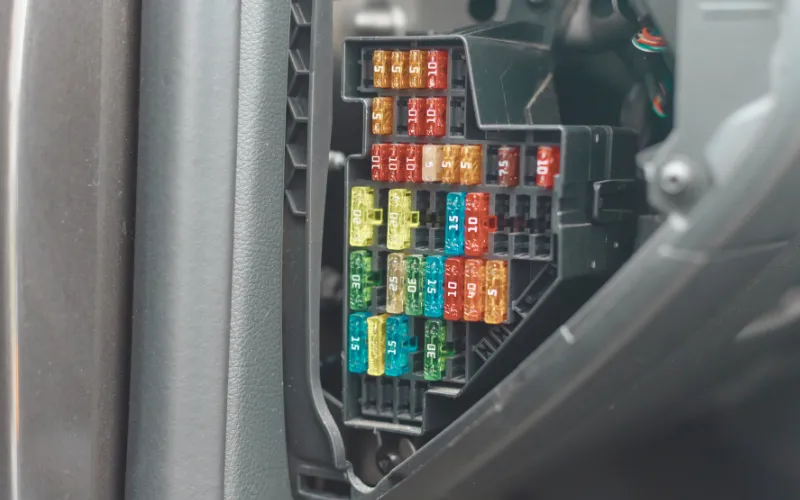How Does A Fuse Make The Circuit Safer
Electrical safety is a paramount concern in both residential and commercial settings. A fuse is one of the simplest yet most effective components ensuring this safety.
This article explores the function of fuses in electrical circuits, how they contribute to safety, and why they are an essential part of any electrical system.
Understanding Fuses and Electrical Safety
Electrical safety is a critical aspect that should never be overlooked in any setting where electrical systems are in use. Fuses are integral in maintaining this safety, safeguarding against potential electrical hazards.
To fully understand the importance of fuses and how they contribute to electrical safety, it’s essential to delve deeper into their function, types, and the principles behind their operation.
What is a Fuse?
A fuse is a protective device designed to limit the flow of electrical current in a circuit. It consists primarily of a metal wire or filament that melts when exposed to high currents, thus breaking the circuit and stopping the flow of electricity.
This simple yet effective mechanism protects electrical appliances and wiring from damage caused by excessive current or overload conditions.

How Do Fuses Work?
Fuses are designed to carry a specific maximum current, known as the rated current. When the current flowing through the circuit exceeds this rated current due to an overload or fault, the temperature of the wire in the fuse increases until it melts.
The melting of the wire creates a gap in the circuit, interrupting the flow of electricity and consequently protecting the circuit from damage.
The speed at which a fuse blows depends on the wire’s material and the current amount exceeding the fuse’s rating. This is crucial in preventing damage to sensitive electrical components and preventing fires caused by overheating wires.
Types of Fuses
There are several types of fuses, each designed for specific applications and levels of current protection:
- Plug or Cartridge Fuses: These are the most common types of residential wiring. They screw into a socket and are used to protect lighting and other household circuits.
- Glass Tube Fuses: Often used in automotive and small appliance applications, these fuses allow a clear view of the fuse wire and provide fast-acting protection against overcurrent.
- Ceramic Fuses: These are similar to glass tube fuses but made from ceramic to withstand higher temperatures. They’re used in more significant industrial applications.
- Blade Fuses: These are commonly used in vehicles, color-coded according to their rated current, and provide fast-acting protection.
- High Rupture Capacity (HRC) Fuses: These are industrial-grade fuses designed to handle high current loads and severe fault conditions without exploding or creating a fire hazard.
Importance of Fuse Ratings
Each fuse is rated for a specific voltage and current, which must be carefully selected to match the circuit’s requirements. Using a fuse with too high a rating can result in inadequate protection, while one with too low a rating will blow unnecessarily under normal circuit conditions.
Understanding the correct fuse rating involves considering the maximum current that the circuit is expected to carry under normal conditions and the maximum voltage it can encounter. The selected fuse should have a current rating slightly higher than the normal operating current and a voltage rating equal to the circuit voltage.
How to Choose the Right Fuse
Selecting the correct fuse for your electrical system is crucial for maintaining safety and efficiency. Incorrect fuse selection can lead to unnecessary power outages, potential damage to electrical components, or even fire hazards.
Here’s a detailed guide to help you choose the right fuse for your needs.
Understanding Fuse Specifications
Before selecting a fuse, it’s essential to understand the key specifications:
- Current Rating: This indicates the maximum current the fuse can carry without blowing. It should be slightly higher than the circuit’s normal operating current to prevent nuisance blowing but low enough to protect against overcurrents.
- Voltage Rating: The maximum voltage at which the fuse can safely operate. This should be equal to or greater than the circuit’s operating voltage.
- Breaking Capacity: The fuse’s maximum fault current can safely interrupt without damage. This should be higher than the maximum possible fault current in the circuit.
- Speed of Response: Fuses can be slow-blow (time-delay) or fast-acting. Slow-blow fuses allow temporary current surges without blowing. They are suitable for circuits with motors or transformers while fast-acting fuses blow quickly and are suitable for protecting sensitive electronic devices.

Step-by-Step Guide to Choosing a Fuse
Analyze Circuit Requirements
- Determine the Operating Current: Check the current rating of the devices in your circuit. The fuse should have a current rating higher than the total operating current to handle normal fluctuations without blowing.
- Identify the Voltage: Ensure the fuse’s voltage rating suits your circuit’s voltage. Using a fuse with a voltage rating too low can be hazardous.
Consider the Type of Load
- Resistive Loads: Heaters or lamps typically require fast-acting fuses since they don’t usually experience large current surges.
- Inductive Loads: When switched on, inductive loads, such as motors or transformers, generate current surges. Time-delay (slow-blow) fuses are ideal for these, as they can handle the surge without blowing.
Evaluate Environmental Factors
- Ambient Temperature: High temperatures can reduce a fuse’s operational life, requiring a fuse with a higher temperature rating or derating the current rating.
- Physical Space: Ensure the physical dimensions of the fuse fit the available space in your fuse box or holder.
- Special Conditions: In environments with high vibration, moisture, or explosive risks, select fuses designed to withstand these conditions.
Compliance and Standards
Ensure the fuse complies with relevant standards and regulations for your area and industry. Depending on your location and application, this might include certifications like UL, CE, or others.
Consult Manufacturer’s Recommendations
Manufacturers often provide guidelines or selection charts for their fuses. These can be invaluable resources for choosing the right fuse for your application.
Testing and Replacement
Proper maintenance of electrical systems includes regular testing and timely replacement of fuses. A multimeter, an essential tool for any electrical work, can be invaluable in this process.
Understanding how to use a multimeter to test fuses is a crucial skill that can prevent potential hazards and ensure that your electrical systems function correctly.
Can Using a Multimeter to Test a Fuse in a Live Circuit Cause Damage?
Testing a fuse using a multimeter in a live (energized) circuit can be dangerous and unnecessary. When a multimeter is set to measure resistance (ohms), it sends a small current through its probes.
If you attempt to test a fuse in a live circuit, this small current from the multimeter could interact unpredictably with the circuit’s existing current.
This interaction could lead to several problems:
- Personal Safety Risk: Electric shock occurs when touching the probes to a live circuit. This can cause injury or even be fatal.
- Damage to the Multimeter: Applying the resistance setting to a live circuit can damage the multimeter, rendering it inaccurate or unusable.
- Circuit Damage: Introducing the multimeter’s test current into a live circuit could potentially cause damage to sensitive electronic components within the circuit.
- False Readings: Testing a fuse in a live circuit can give false readings, leading to incorrect conclusions about the fuse’s condition.
Therefore, it’s crucial always to ensure that the circuit is powered off and safely isolated before testing a fuse with a multimeter. This ensures accurate readings and, more importantly, personal safety.
If you are unsure or inexperienced with electrical systems, consulting with or hiring a professional electrician to perform electrical tests and repairs is always best.
Conclusion
Fuses are essential to any electrical system, providing an inexpensive yet effective line of defense against overcurrent and short circuits. Understanding how fuses contribute to electrical safety can help protect your electrical system, reducing the risk of damage and fire.
Regular inspection and correct fuse selection are key to maintaining a safe and functional electrical environment.
Frequently Asked Questions
Can a fuse be reused after it has blown?
No, once a fuse has blown, it must be replaced. The metal wire or strip inside the fuse melts and cannot be repaired.
How do I know if a fuse has blown?
A blown fuse usually shows a broken metal strip through a clear glass casing. If the casing is unclear, the circuit affected by the fuse will not function.
Are fuses better than circuit breakers?
Fuses and circuit breakers serve the same purpose but in different ways. Fuses are more cost-effective and faster to respond to overcurrent, but they must be replaced after blowing. Circuit breakers, on the other hand, can be reset.

Author
Alex Klein is an electrical engineer with more than 15 years of expertise. He is the host of the Electro University YouTube channel, which has thousands of subscribers.
